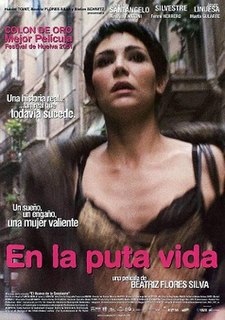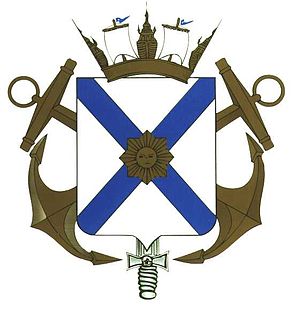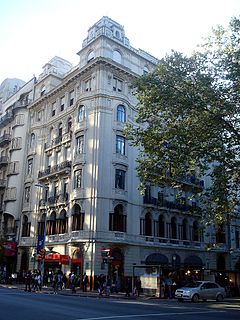Related Research Articles

Uruguay, officially the Oriental Republic of Uruguay, is a country in South America. It shares borders with Argentina to its west and southwest and Brazil to its north and northeast; while bordering the Río de la Plata to the south and the Atlantic Ocean to the southeast. It is part of the Southern Cone region of South America. Uruguay covers an area of approximately 181,034 square kilometers (69,898 sq mi) and has a population of an estimated 3.51 million, of whom 2 million live in the metropolitan area of its capital and largest city, Montevideo.

The economy of Uruguay features an export-oriented agricultural sector and a well-educated workforce, along with high levels of social spending. Tourism and banking are also important sectors; Uruguay acts as a regional hub for international finance and tourism. The country also has a history and representation of advanced workers-rights protection, with unions and the eight-hour work-day protected at the beginning of the 20th century.

Entre Ríos is a central province of Argentina, located in the Mesopotamia region. It borders the provinces of Buenos Aires (south), Corrientes (north) and Santa Fe (west), and Uruguay in the east.

Sport in Uruguay has been an important part of Uruguayan culture, since the early start of the nation. Winners of such important awards such as the FIFA World Cup, the French Open, and Olympic medals, Uruguay has been a constantly successful sports nation in continental and world aspects.
The Australian Film Commission (AFC) was an Australian government agency was founded in 1975 with a mandate to promote the creation and distribution of films in Australia as well as to preserve the country's film history. It also had a production arm responsible for production and commissioning of films for the government. It was superseded by Screen Australia from 1 July 2008.
Uruguay is the only country in Latin America that has achieved quasi-universal coverage of access to safe drinking water supply and adequate sanitation. Water service quality is considered good, with practically all localities in Uruguay receiving disinfected water on a continuous basis. 70% of wastewater collected by the national utility was treated. Given these achievements, the government's priority is to improve the efficiency of services and to expand access to sewerage, where appropriate, in areas where on-site sanitation is used.

Channel 10 is a Uruguayan free-to-air television channel based in Montevideo, founded in 1956 by Raul Fontaina as the first TV broadcaster in the country and the fourth in Latin America. SAETA ("Arrow") is a backronym for "Anonymous Society of Television Broadcasting and Appendants". The channel is owned by Grupo Fontaina - De Feo.

A Place in the World is a 1992 Argentine drama film co-written, co-produced and directed by Adolfo Aristarain, and starring Federico Luppi. It stars José Sacristán, Federico Luppi, Leonor Benedetto and Cecilia Roth.

The cinema of Uruguay has a role in the culture of Uruguay and is a part of Latin American cinema. Since the late 1990s, Uruguayan cinema has undergone a process of evolution, during which its films have received positive reviews and been internationally recognized. Over 120 films, fiction and non-fiction, have been produced since then.

In This Tricky Life is a 2001 film directed by Beatriz Flores Silva. It was Uruguay's submission to the 74th Academy Awards for the Academy Award for Best Foreign Language Film, but was not accepted as a nominee. The film was awarded the 'Golden Columbus' at the Huelva Ibero-American Film Festival. An international co-production among companies from Uruguay, Belgium, Spain and Cuba, the film was produced by BFS Producciones, Saga Film, Avalon Productions and ICAIC.

The National Navy of Uruguay is a branch of the Armed Forces of Uruguay under the direction of the Ministry of National Defense and the commander in chief of the Navy.

Energy in Uruguay describes energy and electricity production, consumption and import in Uruguay.

Álvaro Brechner is a Uruguayan film director, writer and producer that lives in Spain.

Palacio Chiarino is a French Neoclassical building located on the corner of Plaza de Cagancha and Avenue 18 de Julio in the center of Montevideo, Uruguay. Its construction began in 1922 and finished in 1928. The architects Antonio Chiarino, Bartolome Triay and Gaetano Moretti was commissioned to create the design for the Arturo Soneira family. Moretti died before the building was completed. Moretti also designed Palcio Legislativo in Montevideo, Uruguay.

Cannabis is legal in Uruguay, and is one of the most widely used drugs in the nation.
The Uruguayan savanna ecoregion used to be covered by grasslands, palm savannas, and gallery forests along the Uruguay, Negro, Yaguarí, Queguay, and Tacuarembó rivers. Unfortunately, agriculture and cattle ranching have heavily altered these natural communities. The savannas are critically endangered because there are few small isolated patches of intact habitat remaining. The whole ecoregion has been severely altered by cattle ranching, one of the main pillars of the national economy in Uruguay. About 80% of Uruguayan territory is used for cattle ranching on natural and artificial savannas.
Zanahoria is a 2014 film directed by Enrique Buchichio. Inspired by real events, it is a suspense drama, a Uruguayan-Argentine co-production filmed in Uruguay.
The Military ranks of Uruguay are the military insignia used by the Armed Forces of Uruguay.
References
- ↑ "Uruguay finds film mojo". Variety . 9 October 2009. Retrieved 7 June 2011.